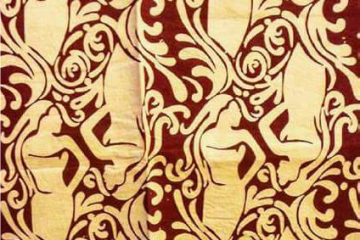Gowa Empire is one of empires that had been established in South Sulawesi. This empire began with 9 small empires, also named as Kasuwiyang Salapang which was often conflict each other. The conflicts happened for a long time, until Tomanarung came. The Tomanarung then became the first Gowa’s King and the world known Gowa Empire from the late of 16th Century until early of 17th Century. Sultan Alauddin, Gowa King the XIV had brought Gowa into its gloried.
Somba Opu Fort
Somba Opu Fort is located in Sapiria, Somba Opu, Gowa, South Sulawesi. This fort was the main fort of Gowa Empire. The history of the fort was divided into several phases.
The first phases was the construction of Somba Opu Fort, which was happened on the era of Gowa King the IX. In 1525, Gowa King asked his people to build a wall from clay around Somba Opu City. After that, the center government of Gowa Empire moved from Kale Gowa Fort to Somba Opu Fort.
Second phases happened on the era of King Gowa the X. On his era, King Gowa the X strengthened the wall structure with bricks. Besides, the king also asked his staffs to build dewala and fort and completed it with some cannons. The Somba Opu Fort was not only used as a main fort, but also as a commercial city. Some settlements of Malay and Portuguese traders were built on the south side of Somba Opu Fort.
The third phases was on King Gowa the XII’s era. To strengthened the fort, the king’s ordered to rigged the fort with more bricks and cannons.
On the fourth phases, King Gowa the XIV, Sultan Alauddin completed and reinforced the fort with tens of cannons. On this time, the center of government moved back to Kale Gowa Fort, and the Somba Opu Fort became the city of the king and also commercial city that had been managed by the syahbandar. The expansion of Somba Opu Fort was closed relate to the fall of Malaka to Portuguese impact in 1511.
The fifth phases, still on Sultan Alauddin’s era (1653 – 1670), the Somba Opu Fort was back become the center of government of Gowa Empire. This phases also became the last phases of its life because of the fort was down felt, related to the defeated of Sultan Hasanuddin from the Netherlands. On June 24 1699, Somba Opu Fort was claimed by the Netherlands, to be destroyed.
Somba Opu Fort was rebuilt and reconstructed on 1980. Now, the Fort being the historical and cultural tourist attraction.
Katangka Mosque
Katangka Mosque is located in Syekh Yusuf Street, Katangka, Somba Opu, Gowa, South Sulawesi.
The Old Katangka Mosque is the first and the oldest mosque in Gowa that was built on the era of The King Gowa the XIV, Sultan Alauddin in 1603. The name of the mosque was given by a charming Syufi, Syekh Yusuf Al Makassar, whom was adored by the people of South Sulawesi and also the relatives of the king.
This mosque has 212,7 m2 width and bordered by an iron hedge. The architecture of the mosque was mixed from Makassar and Moslem building. Inside the mosque, there are soko guru pole, rotrum, and mihrab. There are a Kerawang ornaments besides the single entry of the mosque.
The three doors on the center of the pray rooms has an Arabic inscription with Makassar language on the top. The roof of the mosque is tile-three-storied with a four-windows-room as a separator between two and three stories.
Sultan Hasanuddin Cemetery Complex
The Complex of Sultan Hasanuddin Cemetery is on the top of the Tamalate hill in Katangke District, Somba Opu, Gowa. This location can be reached by 2 ways, from Syekh Yusuf Street, which is only 1 km far, or by Pallantikang Street, with 1.5 km far.
In this area, there are 14 cemeteries, which most of them are the cemeteries of Gowa’s Kings. The form of the cemeteries is terraces punden with susun timbun system including cemeteries’ cupola, and a simple dome.
Sultan Alauddin, King Gowa the XIV
I Mangngarangi Daeng Mangrabbia Karaeng Lakiung Sultan Alauddin “Tumenanga ri Gaukanna” was the first of Gowa King whom convert himself to Islam. He was born in 1586 and died on June 15 1639. Oh the era of his throne, he was helped by the Tallo King, Sultan Abdullah. On that time, the Gowa Empire developed into a Maritime empire. He died after being a king for 46 years and was succeed by his son, Sultan Malikussaid.
Sultan Malikussaid, King Gowa the XV
I Mannuntungi Daeng Mattola Karaeng Ujung Karaeng Laikung Sultan Malikussaid “Tumenangan ri Papanbatuna” was the King of Gowa the XV. He was born on December 11 1605 and died on November 6 1653. On his 14 years throne, Sultan Malikussaid brought Gowa Empire into the gloried. He also was being a good father by always carried his son, Hasanuddin into important meetings. The reason was taught Hasanuddin about public administration, diplomacy, and warfare strategy.
Sultan Hasanuddin, King Gowa the XVI
I Mallombasi Daeng Mattawang Muhammad Baqir Karaeng Bontonmangape Sultan Hasanuddin “Tumenanga ri Balla Pangkana” was the second son of Sultan Malikussaid. He was born on January 12 1631. Under his throne, when Gowa Empire became the giant empire, which was controlled the traded in East Indonesia, the colonial, Netherlands was tried to colonize the spices commerce.
This condition, at the end, created war between Gowa and Netherlands. However, the Gowa Empire lost on this battle and made Sultan Hasanuddin resigned from his throne on June 23 1669 and died on June 12 1670. Sultan Hasanuddin was ordered for 16 years, from 1653 – 1669. As his service defeat the colonization of Netherlands, he gave a National Heroes Medals based on the Presidential Regulation number 087/TK/1973 on November 6 1973.


0 Comments